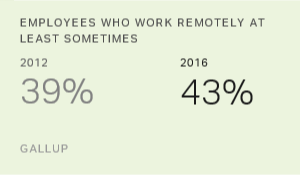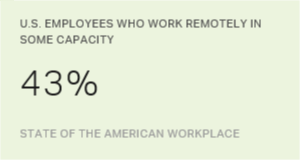Story Highlights
- Working remotely is most effective when there's a home-office balance
- Remote workers say they make a lot of progress in their day
- Autonomy and flexibility could give rise to better performance
This is the second article in a four-part series.
Are employees who work remotely productive and engaged in their jobs? It depends on how much time they spend out of the office.
Overall, Gallup's State of the American Workplace report reveals that engagement climbs when employees spend some time working remotely and some time working in a location with their coworkers. The optimal engagement boost occurs when employees spend 60% to less than 80% of their workweek -- or three to four days -- working off-site.
This pattern emphasizes how remote working has the greatest returns on engagement when employees maintain some degree of balance. They work from home or off-site most of the time but still have an opportunity to get face time with managers and coworkers.
In 2012, Gallup's study of remote workers showed markedly different results. At that time, we found that the optimal engagement boost occurred when employees spent less than 20% of their time working remotely. On the other hand, employees who spent more than half of their time working remotely experienced similar levels of engagement as those who never worked remotely.
Today, the story is different. All employees who spend at least some (but not all) of their time working remotely have higher engagement than those who don't ever work remotely.
Reassuring Results for Leaders
When examining the most engaged group of remote employees (those who work remotely 60% to less than 80% of the time), Gallup finds that they are the most likely of all employees to strongly agree that their engagement needs related to development and relationships are being met.
In fact, they are the most likely of all employees to strongly agree that someone at work cares about them as a person, encourages their development and has talked to them about their progress. They are also the most likely of all employees to strongly agree that they have a best friend at work and opportunities to learn and grow.
Gallup also discovered that employees who work remotely 60% to less than 80% of the time are 31% more likely than are employees who work remotely 40% to less than 60% of the time to strongly agree that they make more progress in their workday.
These results should reassure leaders that spending some time in a location different from coworkers is not detrimental to many employees' engagement or progress. In fact, the autonomy and flexibility could give rise to better performance and employees who feel more connected to their company.
That said, the effects of working remotely are not the same for employees who work remotely 100% of the time or for those with particular job functions. Marked differences appear when exploring these more closely.
The next article in this series shows how fully remote workers miss out on meaningful connections and conversations with colleagues.
To learn more about how to engage your remote workforce, we invite you to:
- download the most recent State of the American Workplace report
- watch our on-demand webinar "Managing Your Remote Workers"


